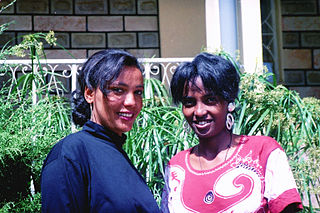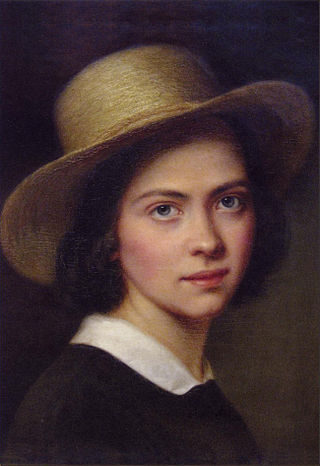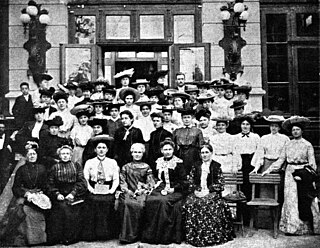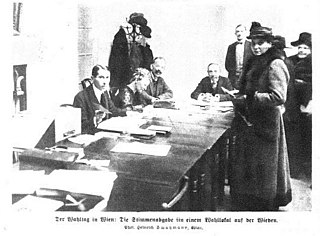Cohabitation is an arrangement where people who are not married, usually couples, live together. They are often involved in a romantic or sexually intimate relationship on a long-term or permanent basis. Such arrangements have become increasingly common in Western countries since the late 20th century, being led by changing social views, especially regarding marriage, gender roles and religion.

Women's rights are the rights and entitlements claimed for women and girls worldwide. They formed the basis for the women's rights movement in the 19th century and the feminist movements during the 20th and 21st centuries. In some countries, these rights are institutionalized or supported by law, local custom, and behavior, whereas in others, they are ignored and suppressed. They differ from broader notions of human rights through claims of an inherent historical and traditional bias against the exercise of rights by women and girls, in favor of men and boys.
Gender equality, also known as sexual equality or equality of the sexes, is the state of equal ease of access to resources and opportunities regardless of gender, including economic participation and decision-making; and the state of valuing different behaviors, aspirations and needs equally, regardless of gender.

The roles of women in Hungary have changed significantly over the past 200 years. Historically, in the present day territory of Hungary, discourses on women’s roles, rights, and political access, along with feminist movements, have developed within the context of extremely traditional gender roles that were influenced by Roman Catholicism, Lutheranism and Calvinism. More recently, the Communist doctrine on women’s place in society was also influential. The post-communist era in Hungary has produced a number of organizations to address the needs of the nation’s women and mobilize female voters, and several universities now have gender studies programs. In the 21st century, the entry in the European Union has led to a more 'Westernized' culture.

There have been several studies concerning women in Ethiopia. Historically, elite women in Ethiopia have been visible as administrators and warriors. This never translated into any benefit to improve the rights of women, but it had meant that women could inherit and own property and act as advisors on important communal matters. As late as the first part of the 20th century, Queen Menen, consort of Emperor Iyasu IV, had a decisive role in running the Ethiopian Empire. Workit and Mestayit regents to their minor sons have been held responsible for their provinces. They owed their rights to landed property because of a special type of land tenure that expected tenants to serve as militia to overlords, irrespective of gender. In 1896, Empress Tayetu Betul, wife of Emperor Menelik II, actively advised the government and participated in defending the country from Italian invasion. Prominent and other landowning women fought against the second invasion in 1935–41. With the assistance of European advisors, women in the ensuing period were kept out of the army and politics, even as advisors. Instead, they were restricted to family and household work of raising children and cooking. With a steady increase in female representation in education, they have started to undertake nursing, teaching, and other similarly supportive roles. Over the 2018–2019 period, their gradual participation in state politics has been increasing at a steady pace.

It is thought that multiple ethnic groups in South Africa have long-standing beliefs concerning gender roles, and most are based on the premise that women in South Africa are less important, or less deserving of power, than men. Some view African traditional social organizations as male centered and male dominated. One prevailing caricature of Afrikaner religious beliefs includes a strong emphasis on the theoretically biblically based notion that women's contributions to society should normally be approved by, or be on behalf of, men. Claims are even made of modern sexism and Christianity being introduced into South Africa by the ancestors of the Afrikaner diaspora.

Child marriage in India, according to the Indian law, is a marriage where either the woman or man is below the age of 21. Most child marriages involve girls, many of whom are in poor socio-economic conditions.

Domestic violence in India includes any form of violence suffered by a person from a biological relative but typically is the violence suffered by a woman by male members of her family or relatives. Although Men also suffer Domestic violence, the law under IPC 498A specifically protects only women. Specifically only a woman can file a case of domestic violence. According to a National Family and Health Survey in 2005, total lifetime prevalence of domestic violence was 33.5% and 8.5% for sexual violence among women aged 15–49. A 2014 study in The Lancet reports that although the reported sexual violence rate in India is among the lowest in the world, the large population of India means that the violence affects 27.5 million women over their lifetimes. However, an opinion survey among experts carried out by the Thomson Reuters Foundation ranked India as the most dangerous country in the world for women.

The roles of German women have changed throughout history, as the culture and society in which they lived had undergone various transformations. Historically, as well as presently, the situation of women differed between German regions, notably during the 20th century, when there was a different political and socioeconomic organization in West Germany compared to East Germany. In addition, Southern Germany has a history of strong Roman Catholic influence.

The status of women in Spain has evolved from the country's earliest history, culture, and social norms. Throughout the late 20th century, Spain has undergone a transition from Francoist Spain (1939-1975), during which women's rights were severely restricted, to a democratic society where gender equality is a fundamental principle. As such, during the past decades the position of women in Spanish society has greatly improved. Women in the broader Spanish population outnumber men by 900,000, totaling an estimated group of 24 million. Until the establishing of separation of church and state in 1978, the Catholic Church in Spain has played a major role with regard to official views on women's role in society.

The roles of women in France have changed throughout history. In 1944, French women obtained women's suffrage. As in other Western countries, the role of women underwent many social and legal changes in the 1960s and 1970s. French feminism, which has its origins in the French Revolution, has been quite influential in the 20th century with regard to abstract ideology, especially through the writings of Simone de Beauvoir. In addition the article covers scholarly work on topics in history, education, reproductive rights, families, feminism, domestic violence, religion and art.

Women in Australia refers to women's demographic and cultural presence in Australia. Australian women have contributed greatly to the country's development, in many areas. Historically, a masculine bias has dominated Australian culture. Since 1984, the Sex Discrimination Act 1984 (Cth) has prohibited sex discrimination throughout Australia in a range of areas of public life, including work, accommodation, education, the provision of goods, facilities and services, the activities of clubs and the administration of Commonwealth laws and programs, though some residual inequalities still persist.

The character of Polish women is shaped by Poland's history, culture, and politics. Poland has a long history of feminist activism, and was one of the first nations in Europe to enact women's suffrage. It is also strongly influenced by the conservative social views of the Catholic Church.

Women in Switzerland are women who live in and are from Switzerland. The legal and social role of Swiss women has evolved significantly from the mid-20th century onwards.

Women in Belgium are European women who live in or are from Belgium. Generation after generation, Belgian women are able to close the "occupational gender gap". In younger generations, this is due to the increasing availability of "part-time jobs in services" for women. In 1999, the average earnings of a Belgian woman was 91 percent of the salary of a Belgian man. When not doing part-time jobs, Belgian women still "do more of the domestic work", depending on the agreement between female and male partners.

The modern-day character and the historical status of women in Denmark has been influenced by their own involvement in women's movements and political participation in the history of Denmark. Their mark can be seen in the fields of politics, women's suffrage, and literature, among others.

Feminism in South Africa concerns the organised efforts to improve the rights of the girls and women of South Africa. These efforts are largely linked to issues of feminism and gender equality on one hand, and racial equality and the political freedoms of African and other non-White South African ethnic groups on the other. Early feminist efforts concerned the suffrage of White women, allowing them to vote in elections beginning from 1930s, and significant activism in the 1950s to demand equal pay of men and women. The 1980s were a major turning point in the advancement of South African women, and in 1994, following the end of the apartheid regime, the status of women was bolstered by changes to the country's constitution. Since the end of apartheid, South African feminism is a contribution associated with the liberation and democratization of the country, however, the movement still struggles with the embedded conservative and patriarchal views within some segments of South African society.

The Allgemeiner Österreichischer Frauenverein was an Austrian women's organization for women's suffrage, active between 1893 and 1919.

Marie Lang was an Austrian feminist, theosophist and publisher. Born in 1858 in Vienna, Lang was raised in a liberal, upper-middle-class home. After divorcing her first husband in 1884, she married Edmund Lang and the two hosted an influential salon for politicians and intellectuals. Joining the women's movement toward the end of the 1880s, she quickly became an influential women's rights activist. In 1893, along with Auguste Fickert and Rosa Mayreder, she founded the Allgemeiner Österreichischer Frauenverein. In spite of provisions in Section 30 of the law governing associations, which prohibited women's political involvement, the three friends used their networks of influential politicians and intellectuals to press for legal changes in laws governing women and children's civil rights and in favor of women's suffrage. In 1898, she co-founded the women's journal Dokumente der Frauen, serving as its editor-in-chief until 1902.

Women's suffrage was introduced in Austria on 12 November 1918 with the foundation of the Republic of Austria after the fall of the Habsburg monarchy with the end of World War I. While men had gained the right to vote in the years of 1861 until 1907, women were explicitly excluded from political participation since the February Patent in 1861.



















